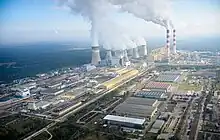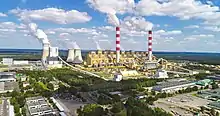| Bełchatów Power Station | |
|---|---|
.jpg.webp) Bełchatów Power Station | |
| Official name | Elektrownia Bełchatów |
| Country | Poland |
| Location | Bełchatów, Łódź Voivodeship |
| Coordinates | 51°15′59″N 19°19′50″E / 51.26639°N 19.33056°E |
| Status | Operational |
| Commission date | 1982 |
| Owner(s) | PGE |
| Operator(s) | PGE GiEK – Elektrownia Bełchatów |
| Thermal power station | |
| Primary fuel | Lignite |
| Power generation | |
| Units operational | 11 x 370/380 MW 1 x 858 MW |
| Nameplate capacity | 5,102 MW[1] |
| Annual net output | 27–28 TWh |
| External links | |
| Website | elbelchatow |
| Commons | Related media on Commons |


The Bełchatów Power Station is a coal-fired power station near Bełchatów, Poland. It is the largest thermal power station in Europe. The power station is owned and operated by PGE GiEK Oddział Elektrownia Bełchatów, a subsidiary of Polska Grupa Energetyczna.
In 2011, a new 858 MW unit was commissioned increasing the total capacity of the power to 5,053 MW.[2] The new unit has an efficiency rating of approximately 42%, contributed to reduction of both fuel consumption and emissions compared to the older units.[3] The unit has been built by Alstom.[4] Alstom also has modernized the low pressure parts in all 12 turbines and, in 2009, PGE and Alstom signed a contract to modernise unit 6.[4] After modernization of other units, the total installed capacity reached 5,420 MW in 2015.[1] In 2017, the electrical capacity of Elektrownia Bełchatow was increased to 5,472 MW. The plant's current achievable capacity is 5,102 MW. In the second half of 2019, the achievable capacity was reduced due to the decommissioning of the oldest unit (unit No 1).
The station's flue gas is vented through two 300 m (980 ft) tall chimneys, among Poland's tallest free-standing structures. Lignite (brown coal) for the plant is provided by a large neighboring strip mine Bełchatów coal mine.
The building of the power station itself has a height of 118 metres, a length of 740 metres and a width of 117 metres.
Carbon dioxide emissions
Bełchatów is the fifth largest coal-fired power plant in the world.[5] According to estimates, in 2018, it emitted 37.6 million tons of carbon dioxide, more than any other power station, with relative emissions estimated at 1.756 kg per kWh. The plant releases more carbon dioxide each year than the entirety of Switzerland.[6][7]
In order to reduce CO2 emissions, PGE sought to introduce carbon capture and storage technology. In 2008, it signed a memorandum of understanding with Alstom, according to which Alstom would design and construct a pilot carbon capture plant at Unit 12 by mid-2011. A larger carbon capture plant was to be integrated with the new 858 MW unit by 2015.[8] The project failed to receive a European Commission grant for €180 million from the European Energy Programme for Recovery,[9][10] and was cancelled in 2013.[11]
Future
In September 2020, the District Court in Łódź ordered settlement talks between PGE GiEK and ClientEarth regarding the reduction of the environmental and climate impact of the Bełchatów Power Plant.[12]
On October 19, 2020, PGE Polska Grupa Energetyczna published the Group's new strategy[13] for the decade running up to 2030 with an outlook to 2050. The company presented the Group's transition and decarbonisation plan and announced the goal of achieving climate neutrality by 2050.[14]
The PGE project "Just transformation of the Bełchatów complex" initially consists of photovoltaic farms, wind farms, and a thermal waste treatment installation with energy recovery; it would be the first stage in the process of regional transition towards carbon neutrality.[15]
In June 2021, local authorities published a plan for public consultation that would see the plant decommissioned by 2036, with support from the Just Transition fund.[16]
See also
References
- 1 2 Moc osiągalna w Elektrowni Bełchatów wzrosła do 5 472 MW, retrieved 20 March 2017
- ↑ Elektrownia Bełchatów pełną mocą, archived from the original on 23 July 2012, retrieved 7 August 2011
- ↑ Brück, Martin. "Cooling flue gas to maximize power plant efficiency". Power Engineering International. PennWell Corporation. Archived from the original on 25 June 2010. Retrieved 20 June 2010.
- 1 2 "Alstom signs a €160 million contract with PGE to modernise the Bełchatów power plant in Poland" (Press release). Alstom. 8 April 2009. Archived from the original on 30 March 2012. Retrieved 20 June 2010.
- ↑ "Profiling the top five biggest coal power plants in the world". Retrieved 4 October 2021.
- ↑ Grant, Don; Zelinka, David; Mitova, Stefania (2021). "Reducing CO2 emissions by targeting the world's hyper-polluting power plants". Environmental Research Letters. 16 (9): 094022. doi:10.1088/1748-9326/ac13f1. ISSN 1748-9326.
- ↑ Fox, Alex (4 August 2021). "Just 5 Percent of Power Plants Release 73 Percent of Global Electricity Production Emissions". Smithsonian Magazine. Archived from the original on 6 August 2021.
The power plant with the highest greenhouse gas emissions is the 27-year-old Bełchatów plant in Poland. The plant produces 20 percent of Poland's electricity
- ↑ "Alstom teams up with PGE Elektrownia Bełchatów to reduce CO2 output in Poland" (Press release). Alstom. 8 December 2008. Archived from the original on 30 March 2012. Retrieved 20 June 2010.
- ↑ "List of 15 energy projects for European economic recovery". European Commission. 9 December 2009. Retrieved 20 June 2010.
- ↑ "EU lines up funding for six carbon capture projects". Power Engineering International. PennWell Corporation. 7 October 2009. Retrieved 20 June 2010.
- ↑ STEFANINI, SARA (21 May 2015). "Green Coal in the Red". Politico. Politico. Retrieved 21 November 2017.
- ↑ KRO. "Elektrownia Bełchatów. Sąd nakazał rozmowy o ograniczeniu jej szkodliwości na środowisko". www.money.pl (in Polish). Retrieved 20 November 2020.
- ↑ S.A, PGE Systemy. "Grupa - Strategia". www.gkpge.pl (in Polish). Retrieved 20 November 2020.
- ↑ S.A, PGE Systemy. "Press center - Press releases - Corporate - PGE Group's strategy: climate neutrality in 2050". www.gkpge.pl. Retrieved 20 November 2020.
- ↑ "Raporty – Zielona Transformacja" (in Polish). Retrieved 20 November 2020.
- ↑ "Poland to close Europe's most polluting power plant by 2036". TheGuardian.com. 9 June 2021. Retrieved 9 June 2021.